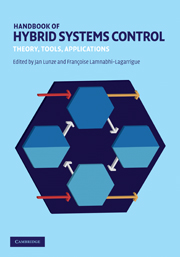Preface
Published online by Cambridge University Press: 21 February 2011
Summary
Hybrid systems are dynamical systems that consist of components with continuous and discrete behavior. Modeling, analysis, and design of such systems raise severe methodological questions, because they necessitate the combination of continuous variable system descriptions like differential and difference equations with discrete-event models like automata or Petri nets. Consequently, hybrid systems methodology is based on the principles and results of the theories of continuous and discrete systems, which, until recently, have been elaborated separately, with contributions coming from different disciplines, such as control theory, computer science, and mathematics.
This handbook reviews the new phenomena and theoretical problems brought about by the combination of continuous and discrete dynamics and surveys the main approaches, methods, and results that have been obtained during the last decade of research in this field. It is structured into three main parts:
Part I: Modeling, analysis, and control design methods: The first part gives a thorough introduction to hybrid systems theory. The material is classified by the modeling approaches used to represent hybrid systems in a form that is convenient for analysis and control design. Hybrid automata and switched systems are well-studied system classes, which are extensively described, but other approaches like mixed logical dynamical systems, complementarity systems, quantized systems, and stochastic hybrid systems are also explained.
Part II: Tools: The second part is concerned with computer-aided systems analysis, control design, and verification. After a survey of the variety of relevant tools, selected tools are described in more detail. […]
- Type
- Chapter
- Information
- Handbook of Hybrid Systems ControlTheory, Tools, Applications, pp. xiii - xvPublisher: Cambridge University PressPrint publication year: 2009
- 1
- Cited by

